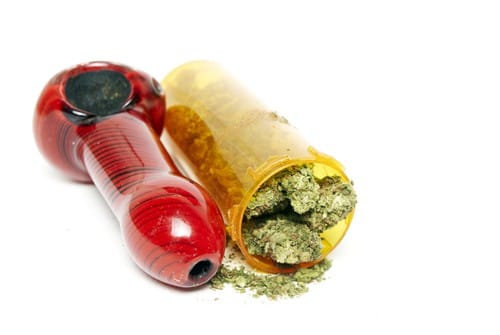While drug use has continued to drop off in most age groups, marijuana has become more popular than ever and continues to be the most used federally illegal drug in the US.
However, just because it is federally illegal doesn’t mean it is completely off-limits – more than 16 states have legalized recreational marijuana, and over 30 states allow the use of medical marijuana, which is part of the reason why it continues to grow in usage in comparison to other substances.
There is a myriad of reasons why the legalization of marijuana is a good thing, especially in the context of the damage its criminalization has done to minority communities and the immense costs of the futile drug-on wars. But policy aside, marijuana remains a controlled substance federally and is prohibited for use among children and teens under 18 years of age.
There are multiple pieces of research pointing towards the long-term negative effects of marijuana use and the existence of marijuana use disorder. Just because it is becoming legal in multiple states doesn’t make it harmless – and just because some people argue that it is less dangerous than certain other substances doesn’t make it so.
Is Marijuana Dangerous?
Marijuana, or cannabis, is a product derived mostly from treated Cannabis indica or Cannabis sativa plants. Different strains come with different characteristic effects and flavors, but most of the differences between types of marijuana can be attributed to either being a Sativa strain or an Indica strain.
The main active component in either type of plant is tetrahydrocannabinol (THC), a cannabinoid with psychoactive effects. Modern-day cannabis is usually bred to produce more or less THC, depending on its uses. Aside from the raw product or treated and dried component, cannabis is also sold and consumed in the form of hash oil, hashish, hash butter, and hemp oil (low THC). In most cases, cannabis is harvested for its leaves and flowering buds.
The effects of THC vary from person to person, in both quality and severity. In general, marijuana use leads to relaxation and euphoria, increased appetite, giggling, and mild changes in visual and aural perception. Increased dosages or increased potency can lead to stronger and more potent changes in perception. Outside of high dosages or concentrated THC, these are relatively rare.
The dangers of marijuana come from both its long-term health problems, consuming both marijuana and alcohol, as well as its effects on perception.
People with pre-existing mental health problems, particularly episodes of psychosis, or a history of schizophrenia, are more likely to trigger a hallucinatory event when consuming marijuana. Marijuana may also make operating heavy machinery much more dangerous, like any intoxicating substance.
Because marijuana has a calming and physically depressive effect, it may compound uniquely with alcohol to induce a dangerous level of memory impairment, difficulty breathing, and paranoia. While most people experience euphoria while taking marijuana, it can also have the opposite effect in some cases, inducing high levels of stress and anxiety.
Finally, the long-term effects of marijuana are still being studied but may include decreased cognitive capacity, memory impairment, lung and throat problems, worsening symptoms of mental illness, and addiction.
There are no confirmed instances of a marijuana overdose, but marijuana can be an influencing factor in different causes of death, including polydrug-induced respiratory failure, vaping injuries or illnesses, and car accidents. Furthermore, high concentration THC marijuana can send people to the emergency room, but it’ll usually be due to severe levels of anxiety, psychotic episodes, or nausea.
First responders called when people take too much marijuana state that the cause is usually an edible rather than smoking the drug. Young children, however, are particularly at risk of eating an edible and becoming violently ill.
Medical Applications for Marijuana
CBD (cannabidiol) has seen much research as a potential medical drug and is legal under federal law. The first FDA-approved use of a cannabinoid was as an antiseizure drug in the treatment of epilepsy. So far, only one other cannabinoid has been approved for medical use, and that is dronabinol. While THC remains illegal, studies have shown that medical marijuana is potentially beneficial for:
- Alzheimer’s disease
- Crohn’s disease
- Amyotrophic lateral sclerosis
- Glaucoma
- Multiple sclerosis
- Cancer treatment-related nausea
- Severe chronic pain
In most cases, medical marijuana may be bred to include lower levels of THC. State-specific qualifications for obtaining medical marijuana differ from state to state. If you do consider using marijuana for medical purposes, beware of its side effects and addiction potential.
How Much Marijuana is Too Much?
Like any other drug, it is impossible to determine a proper limiting dosage to prevent addictive effects. Some people can use marijuana on occasion for years and stop using it forever. Others might struggle to moderate their usage after a few months and end up dependent on the drug for decades.
If used at the behest of a medical professional, limit your dosage strictly to what is prescribed, even when using a low THC strain. Your own predisposition towards THC may be stronger or weaker than average, changing its relative dangerousness.
In any case, THC (and marijuana in general) is an addictive substance and an intoxicating substance.
Signs of Marijuana Use Disorder
Marijuana use disorder may occur in roughly 9 to 30 percent of people who use marijuana regularly. People who use the drug before the age of 18 are up to seven times more likely to develop an addiction. Marijuana use disorder has the same symptoms as other forms of a substance use disorder, namely:
- Inability to quit (constant relapse)
- Hiding marijuana use
- Becoming defensive over their habit
- Struggling at school or at work due to marijuana
- Consuming marijuana much more frequently than normal
Withdrawal symptoms of marijuana include anxiety, loss of appetite, restlessness/insomnia, and irritability.
Seeking Treatment for Marijuana Use Disorder
Treatment for a marijuana use disorder is often necessary, as a common criterion for a substance use disorder is the inability to quit. Teens and adults with marijuana use problems can opt between inpatient or outpatient treatment depending on the severity of their case and their circumstances.
Treatment for a marijuana use disorder begins with detoxification and therapy. Behavioral support is an important element, rewarding people who stay drug-free and providing relevant motivational incentives.
While there are no medications to help treat marijuana use disorder, a patient who began using as a result of their mental health issues (self-medication) will be treated with medication and talk therapy to help them develop healthier coping skills and better long-term stress management options.








